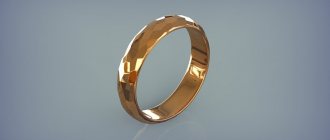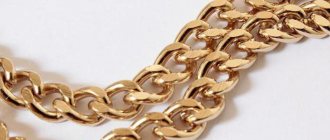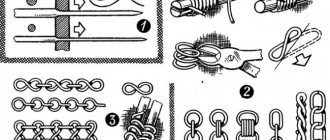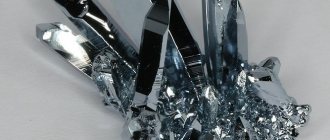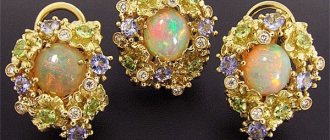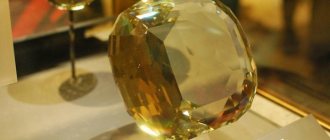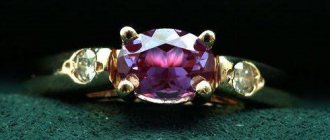One of the most ancient stones is zircon. The age of the stone depends on its deposit; the oldest is the mineral mined in Australia. Its age is more than 4 billion years.
Zircon gemstone has unique physical properties, amazing color and brilliance. However, despite this, although it deserves a place among the most expensive, it was never fully recognized by people.
History and origin
First of all, let's define the terminology.
Zircon is a stone, a natural mineral, which is zirconium orthosilicate - a salt of this metal, a compound with silicon.
Zirconium is a silver-white metal, soft, corrosion-resistant. It is not found in nature in its pure form; it is present in the form of various chemical compounds. For the first time, zirconium metal was obtained from zircon stone.
Faceted and uncut zircon
Cubic zirconia is an artificial zircon. Zirconium dioxide. In jewelry it is used as a budget substitute for diamonds. Even jewelry store sellers often call it zircon, but it has nothing to do with its natural counterpart. The cost of cubic zirconia is much lower than the cost of zircon.
Zircon is a natural mineral of magmatic origin. It may contain up to 4% of the even rarer metal hafnium. Often found in granite, pegmatite, syenite rocks.
Zircon may contain radioactive elements - radium and uranium (in small quantities). The latter is a chromatophore, which gives the stone a green color, so you should not keep green zircons at home.
All zircons have background radiation above the average on Earth, but only green ones can be harmful to health.
The name of the stone goes back to the Persian “zargun”, meaning golden color, the color of the Sun. The stones mined in Persia (modern Iran) were predominantly yellow in color.
Zircon
The ancestral home of this gem is Persia and western India (modern Pakistan and the Indian state of Punjab). In these regions, zircon mining has been carried out since the beginning of the first millennium. Hindus and Persians valued this gem very much; they considered it “the younger brother of diamond,” since the stone is similar to diamond in hardness (although inferior to it) and at the same time has a characteristic diamond shine.
Other names for the mineral are hyacinth, slang, azorite.
It has been known in Europe since the end of the 16th century, but was not considered as an independent precious or semi-precious stone. It was often confused with other gemstones. Zircon became famous at the beginning of the 20th century, when it found both industrial and jewelry applications.
Conclusion
Undoubtedly, creating artificial stones is an expensive proposition, but it is much cheaper than searching for new deposits of diamonds, corundum, topaz and other precious stones. Therefore, cubic zirconium will be in demand for a long time.
it is popular, and this is quite logical: a large number of people want to buy diamond jewelry, but not everyone can afford this option. And exquisitely beautiful cubic zircons, with an equally brilliant shine and variety of colors, are easily accessible to a wide range of viewers. Modern technological processes make it possible to create works of art from a “zirconium cube”.
Physicochemical characteristics
Zircon is a slightly colored or colorless crystal. Hardness: 7.5–8 units on the Mohs scale. It is harder than glass and is on the same level as corundums - ruby and emerald. Characteristics:
- Inferior to diamond.
- Brittle, easily splits.
- The shine is diamond.
Contains many impurities of other metals, both harmless: iron, titanium, aluminum, and relatively dangerous: uranium, strontium, radium, hafnium. The composition may contain iron and calcium oxides.
| Formula | ZrSiO4 |
| Color | Brown, reddish brown, colorless, gray, green |
| Shine | Diamond |
| Transparency | Transparent, translucent, opaque |
| Hardness | 7,5 |
| Cleavage | Implicit |
| Kink | Semi-conchoidal to conchoidal |
| Density | 4.6—4.7 g/cm³ |
Color spectrum
The zirconium cube is transparent and resembles a diamond in appearance. But there are many different additives that can be used to produce different colors. Today there are about 20 shades.
The green color is obtained by adding chromium to the composition. They are used as a copy of emeralds. An analogue of ruby can be achieved using neodymium. The hue saturation is adjusted when the crystals are created.
The addition of cerium produces colors ranging from light yellow to bright red. Erbium makes cubic zirconia pink.
The stone can be black, brown or golden in color. But such species are not very common. The first shade is obtained not by adding certain elements, but by using special heat treatment. The last two are made using titanium impurities.
To obtain blue or light blue cubic zirconia, a special technology is used. An aluminum-cobalt mixture is sprayed over their surface. The process is carried out under vacuum conditions. Stones obtained in this way serve as excellent substitutes for topazes, aquamarines, and sapphires.
Place of Birth
At this time, the main supplier of zircon to the world market is Sri Lanka. It is also the main compromiser of the stone, since island jewelers tend to pass off brilliant-cut zircons as diamonds. Large deposits are being developed in the USA, Canada, Brazil, Norway and Madagascar.
There are few zircon deposits in Russia; it is mainly mined as an accompanying mineral during the development of diamond mines in Yakutia and some deposits of semi-precious stones in the Urals.
Mining is carried out either in placers of granite and other igneous rocks, or in kimberlite pipes. Less often - in a career way.
The stone is rare. Most of the specimens found are very small in size, not reaching even one carat. Large specimens of zircon are very rare.
Interesting Facts
Currently, there are many known ways to obtain precious cubic zirconium. The most common method is crystallization.
In a specialized container, inside of which a special composition is immersed, heated to a temperature of three thousand degrees Celsius. Then they are instantly cooled and crystals form on the rods of the container.
The color of the stone depends entirely on the components included in the composition. Thanks to this feature, cubic zirconia perfectly imitates the most precious and semi-precious stones.
Colors and subtypes
The main color of the stone is reddish brown, ranging from ruby to dark brown. The degree of transparency varies: opaque, translucent, transparent. The worse the transparency, the more impurities of other metals in the stone.
There are no visible inclusions, dots, stripes, or sparkles. After polishing and cutting, zircons acquire the pure appearance of noble crystals.
In addition to red, the following varieties of the mineral are found in nature:
- yellow;
Yellow zircon - grey;
Zircon gray - green;
Green zircon - colorless.
Colorless zircon
The natural yellow subtype of zircon is called jargon. Red or red-brown - hyacinth. Dense brown, almost black - malacon. Colorless - Matar diamond. In addition, blue-blue zircon, similar to sapphire, is used in jewelry, which is never found in nature. It is called starlite and is obtained by annealing hyacinths. Over time, starlites lose their density and brightness of color, so they are less valuable than sapphires.
The green variety of the stone does not have its own name. Green zircons are not used in jewelry because they are hazardous to health.
Medicinal properties
Lithotherapists believe that the healing properties of the stone are primarily due to its internal structure. The zircon crystal has a bipyramidal shape in structure, that is, it follows the contours of a double pyramid. This is what affects the properties of zircon stone.
Zircon
They are most fully manifested in hyacinth. Red stone is inextricably linked with the circulatory and cardiovascular systems. Partially responsible for regeneration, that is, the body’s ability to heal itself after injury. A ring with a hyacinth insert, worn on the middle finger, helps to recover after surgery or injury, accelerates tissue healing in case of external and internal injuries.
A pendant with hyacinth or simply holding a stone closer to the face helps stop nosebleeds. The same pendant or necklace with red or red-brown zircons helps the body maintain good health in case of coronary heart disease.
Jargons, that is, yellow-hued stones, are associated with the liver.
They help the liver better cope with its natural responsibilities - removing toxins and poisons. A jargon ring relieves symptoms of poisoning, including alcohol poisoning.
Dark brown malacons help fight colds and inflammatory processes in the nasopharynx and bronchi. They alleviate the patient's condition with pneumonia, advanced sinusitis, acute rhinitis and sinusitis.
Zircon
Colorless Matar diamonds promote weight loss and muscle tone. In addition, all zircons, without exception, have a beneficial effect on the nervous system.
Beneficial effects on the owner's health
The healing properties of the mineral depend on its color.
Zircon of yellow, orange, golden shades brings relief from diseases of the stomach and liver, helps reduce blood pressure.
Blue - cures diseases of the thyroid and pancreas, promotes weight loss, and also facilitates the course of tumor processes in the brain.
The dark brown, almost black mineral increases the body's resistance to viral infections.
Magic
Zircon has long been considered endowed with the ability to bring success and wealth to its owner. In ancient times, it was the property of sages; it brought them the gift of insight, knowledge of the future, insight into the thoughts and inner world of a person. Set into jewelry pendants and worn as an amulet, zircon serves as protection against unkind people and liars, and promotes the development of memory and observation. It is believed that this is an amulet of judges and criminologists.
There is a belief that in case of difficulties in life, this stone, placed under the pillow before going to bed, will help you come to the right decision in the morning. Zircon of bright colors restores joy, inspires optimism and self-confidence.
Wearing the mineral by self-confident adventurers and scammers can lead to undesirable results. Excessive self-confidence, inspired by the mysterious magic of zircon, deprives people of dangerous professions of caution and leads them to a tragic ending.
Magic properties
In the world of magic, the “little brother of diamond” has a reputation as a lover of truth and a fighter for justice. Like pearls, it does not like deceitful people, but unlike it, it helps its owner identify liars. Zircon gives its owner a sense of lies, hypocrisy and unjustified flattery. If it ends up in the hands of a person engaged in fraud, it can bring its owner to prison.
The properties of zircon are strongly associated with money and high-risk business. Zircon jewelry should be worn by owners of venture companies where it is not clear until the very end whether the development will be successful or not.
Hyacinth and jargon love innovators who honestly risk their money, develop new products, discover new lands - in a word, people who create new things. Therefore, zircon is an ideal talisman for a traveler, researcher, businessman opening foreign markets, inventor or designer.
This is a specific “male” stone, but it is also suitable for some ladies. For girl scientists, earrings made of gold with transparent zircons (not cubic zirconia!) will bring a clear mind, strengthen logical abilities and help look at a well-known problem from a fundamentally different angle.
During the Renaissance, the magical properties of zircon included the ability to preserve a soldier in battle. Red and yellow stones were popular as amulets among European mercenaries - the Genoese, Swiss, and Germans. It was believed that they bestow good luck on those who fight honestly in the front ranks, but do not like cowards.
The magic of mineral
Zircon is a stone of truth and justice. This gem not only does not tolerate deceivers, but also helps the owner to catch people in lies, hypocrisy and flattery, developing the owner’s intuitive abilities. If a fraudster dares to use a gem as a talisman or just a decoration, then the stone will repay him with an evil fate, bringing him to trial and imprisonment.
Zircon prefers to see a man in his owners. However, some girls can also count on friendship with the mineral.
The gem favors female representatives who are engaged in scientific activities. The stone will give them clarity of mind, strengthen logical thinking, and help them consider assigned tasks from different angles.
The mineral provides support to businessmen, especially beginners, who risk losing large sums of money. Such people need to have a gem amulet with them, at least until it becomes clear that the risk is justified.
Also read: Alexandrite - the powerful and unique gem of the Urals
Varieties such as jargon and hyacinth love bold innovators who risk everything without fear. These minerals favor developers of new products, discoverers of new lands, researchers, designers, inventors, all people who bring innovations to this world.
Zodiac compatibility
The magical properties of the stone are most fully revealed among people of Water and Earth - zircon belongs to these elements. But each element has one zodiac sign that zircon does not like. Water has the too soft and feminine Pisces, Air has the too selfish Libra, Earth has the inappropriately stubborn Taurus, Fire has the impetuous and fickle Sagittarius. Neither hyacinth nor any other variety of this mineral is suitable for representatives of these signs. Everyone else can wear it without fear, only gems of the darkest possible shade are recommended for fire signs.
| Zodiac sign | Compatibility |
| Aries | +++ |
| Taurus | — |
| Twins | + |
| Cancer | — |
| a lion | + |
| Virgo | + |
| Scales | — |
| Scorpion | + |
| Sagittarius | — |
| Capricorn | + |
| Aquarius | +++ |
| Fish | — |
(“+++” – fits perfectly, “+” – can be worn, “-” – is strictly contraindicated)
What do the stars say?
Horoscope influences the lives of many people. Both ordinary citizens and rulers believe in predictions from the stars, and this has always been the case, since the creation of the world. Therefore, it has long been noted who this stone is suitable for and who should choose another jewel.
So, one of the signs favored by the mineral is Sagittarius. People born under his auspices often cannot find harmony between the physical and spiritual worlds. Zirconium helps to cope with this problem, then Sagittarius gets the opportunity to fully reveal their business and leadership qualities.
People born under the sign of Aquarius will be able to develop their intuition with the help of zirconium talismans. For Taurus, the stone will give confidence in their own abilities and maintain vital energy.
The effect of the mineral on different zodiac signs is actually the same. The differences lie only in the character traits of people, which he reveals.
He also singles out such signs as Cancer and Pisces. But the difference is that wearing the mineral is contraindicated for them, since it enhances the not-so-good qualities of these signs. For example, Cancer becomes self-centered, and Pisces can plunge into the world of illusions and their own fantasies.
Of all the jewelry, it is best to choose rings. In addition, the mineral is more suitable for men than women.
Compatibility with other stones
The meaning of the “little brother of diamond” in terms of belonging to the elements is the union of Earth and Water; in astrological terms, it is under the auspices of Jupiter. This stone is picky about its neighbors. He categorically protests against a diamond or a brilliant, and does not like rubies, which shine brighter than himself. The Union of Earth and Water sees Fire as its main enemy, so grenades are also “in the air.”
Ring with zircon
The best neighbors for this gem are the minerals of Earth and Water, except for morion. It is incompatible with Morion due to planetary incompatibility.
Zircon goes well with:
- with agates and chalcedony of various types;
- jasper;
- heliotrope;
- malachite;
- turquoise;
- emerald;
- opal;
- aventurine;
- serpentine;
- melanitis;
- Labrador
The combination with Air minerals is questionable. It is impossible to predict how each of these stones will behave. Therefore, it is everyone’s personal choice whether to wear zircon at the same time:
- with crystal;
- lapis lazuli;
- smoky quartz;
- amethyst;
- amazonite;
- chrysoprase.
Scope of application
The area of application of jewelry-quality zircons of all colors is inserts into jewelry. The best frame is considered yellow gold, silver is found, platinum is not used. There is expensive, elite jewelry with hyacinths, malacons and starlites.
Ring with clear zircon
Zircon jewelry includes earrings, rings, pendants, and less commonly, tiaras and pendants. Necklaces are rare.
The main role assigned to clear crystals is to be substitutes for diamonds. They are cheaper than a diamond, but more expensive than cubic zirconia.
The main types of cuts are diamond or cabochon.
The price per gram of this mineral starts at $50, depending on its quality.
Price, where to buy?
Cubic zirconia is often purchased in bulk, from hundreds or more, so the colors are approximate.
It's best to look at the prices yourself:
- A pack of small, colorless stones will cost about $10.
- A pack of small but colorful stones also costs about $25.
- And a package of large stones starts from $40, since their production requires complex technologies.
Ways to recognize a fake
Ironically, zircon itself often serves as a counterfeit diamond to unscrupulous jewelers. An appraiser can recognize it by examining it under a magnifying glass - a diamond has a single, rather than double, refraction of light. Also, a heat-conducting probe helps identify the younger brother of a diamond, posing as an older one.
In turn, zircon, using a play on words, is often passed off as cubic zirconia (cubic zirconia is zirconium oxide). At the same time, cubic zirconia is heavier.
The only reliable way to independently distinguish cubic zirconia from zircon is to check the stone under a magnifying glass in bright light. You will notice an optical illusion - double the shine on the crystal edges. It is given by a bipyramidal structure - a signature feature of zircon.
How to wear and care
The traditional place for a hyacinth ring is on the middle finger. If in gold, then on the right hand, in silver - on the left.
Product with zircon
The stone is highly hard, but brittle. Does not withstand impact: after an accidental impact with a wall or other object, a crack or chip may form on the surface of the stone. Therefore, you need to wear any jewelry with this gem extremely carefully, avoiding any impacts. Prolonged exposure to direct sunlight is also not recommended, especially for starlites - under their influence they gradually lose color saturation.
You need to wash earrings, a ring or a pendant with zircon with a simple soap solution.
If the area is heavily soiled, gentle kitchen chemicals are acceptable, but the best means of cleaning is a hard toothbrush with tooth powder.
Whose name suits zircon?
Whether a stone is favorable or not can be found out in another way. It is believed that a person's name influences his character. Zircon suits everyone whose name is:
- Galina. The mineral helps cope with melancholy. Women and girls are becoming more open and sociable.
- Nina. The gem gives peace of mind.
- Diana. The stone especially helps in business and at work. The gem attracts material wealth.
- Matvey. He becomes luckier and his health improves.
- Vyacheslav. For people with this name, zircon exhibits stronger protective properties. It becomes easier for Vyacheslav to expose his ill-wishers.
- Nikolai. The stone helps in business. Nikolai becomes even more inquisitive and energetic.
